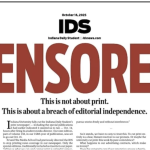About News
How Guilty People Attack the Media

Having been caught using an unauthorized messaging service to discuss details of a military bombing operation with a journalist inadvertently invited into the chat, members of the Trump administration have offered the finest selection of reasons from which gullible people can choose and convince themselves that this highly troubling story is actually no big deal at all.
In fact, the “flood the zone” responses to The Atlantic magazine’s scoop cover pretty much all the different possibilities for propagandist responses when a news organization publishes a negative story about a powerful person or group. Here’s a list of the customary options, all of which we’ve heard or seen from one or more administration officials since the Signal story went public on Monday:
- Attack the accuracy of the story. Even claim fabrication. (In the Signal case, fittingly, one administration official made this claim even after another one had already confirmed authenticity.)
- Engage in a game of meaningless semantics. (The White House points, for instance, to a contrast between “war plans” and “attack plans,” a distinction without a difference.)
- Accuse the reporter of political bias or a personal grudge against the subject. Smear the reporter’s character. (The journalist in the group chat, Atlantic editor-in-chief Jeffrey Goldberg, was deemed “highly discredited” by Defense Secretary Pete Hegseth. Donald Trump called him a “sleazebag.” Another administration official also called him a bag, except that official said the bag was full of scum, not sleaze.)
- Allege illegal or unethical behavior in how the reporter obtained the story. (National Security Adviser Mike Waltz suggested, wrongly, that Goldberg got himself into the meeting by some kind of nefarious plot.)
- Engage in “whataboutism,” meaning to deflect from the issue at hand to talk about a supposedly parallel case that the media supposedly ignored. (White House Press Secretary Karoline Leavitt offered world-record non sequiturs by bringing up Hillary Clinton’s private email server and Hunter Biden’s laptop.)
- Argue that the story isn’t newsworthy. (The White House points to the success of the bombing mission and claims the text messages included no classified information. And come on, people, haven’t we all texted the wrong person by mistake?)
- Threaten some kind of legal action. (OK, this is one I haven’t come across regarding The Atlantic – yet.)
Journalists expect responses like these when they do critical stories. The Atlantic offered a dagger of a comeback by publishing a more complete text chain. News outlets ought to push back. Defend the reputation. And because they need to try to build back their diminishing trust among the public, outlets need to share more of their editorial thinking behind controversial reports. That does not mean, however, getting into back-and-forth shouting matches with the subjects of those reports. Stand behind the journalism, explain it, but let the work itself do most of the talking.
The lesson for the public is this: When you see a wrongdoer respond with one or more (or all!) of the tactics listed here, that’s a pretty good sign that the journalist nailed the story.
 Tom Arenberg is an instructor of news media at the University of Alabama. He worked for The Birmingham News and the Alabama Media Group for 30 years. He published this commentary originally as a post on his blog, The Arenblog.
Tom Arenberg is an instructor of news media at the University of Alabama. He worked for The Birmingham News and the Alabama Media Group for 30 years. He published this commentary originally as a post on his blog, The Arenblog.
About News is a BirminghamWatch feature that publishes commentary by those who teach the craft and think about the values and performance of today’s journalism. BirminghamWatch also publishes About News articles on social sites and invites readers to join the conversation there.


